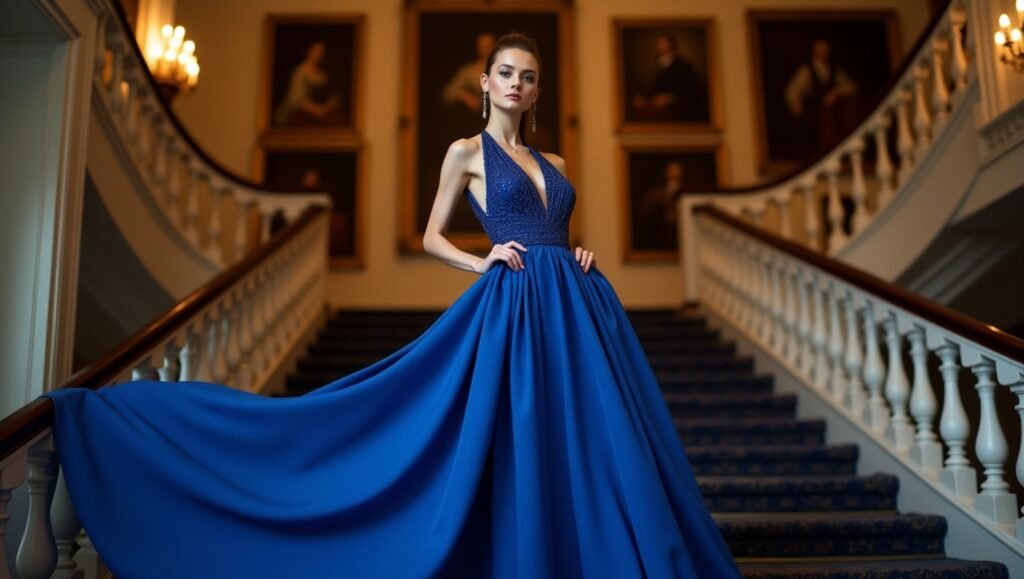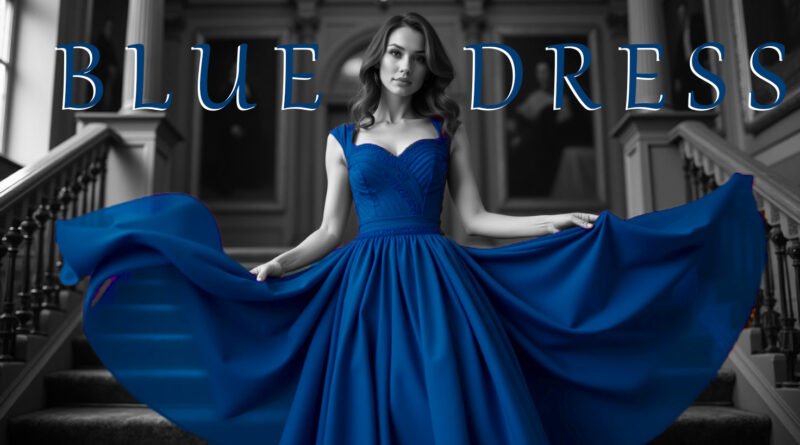Why the Blue Dress Never Goes Out of Style: History, Symbolism & Fashion Secrets

Table of Contents
ToggleA Historical Perspective on the Blue Dress
The history of the blue dress dates back to ancient times, when blue was reserved for the elite, symbolizing wealth, status, and authority across powerful civilizations. The rare and expensive nature of blue dye, particularly the indigo and woad derivatives, meant that only the elite could afford garments in this cherished hue. This exclusivity began in ancient Egypt, where blue was associated with the heavens and favored by rulers. Proof of this can be seen in artifacts depicting pharaohs clothed in lush, blue fabrics, signifying their divine connection.
During the Middle Ages, blue continued to hold its esteemed position in society. As the demand for blue fabrics grew, the trade of dyeing became more sophisticated. Royalty and wealthier classes sported vibrant blue garments, marking themselves as affluent members of society. The Virgin Mary, depicted in art with blue robes, further solidified the color’s symbolic importance, representing purity and grace. This association not only elevated the color but also influenced the decisions of women in their fashion choices.
The blue dress truly emerged as a staple in women’s fashion during the Renaissance period. As artistic expression flourished, so did the variety of textiles and fashions available. The 19th-century introduction of synthetic dyes revolutionized fashion by making blue fabrics more affordable and widely available, enabling people from all walks of life to embrace blue dresses in their everyday attire. Icons such as Queen Victoria popularized the blue gown, often seen in royal portraits adorned with elegant blue hues that captured both delicacy and strength.
In more contemporary fashion, the blue dress has solidified its place as a versatile essential. From the classic little blue dress to the stunning evening gowns seen on red carpets today, the color’s enduring appeal lies in its ability to adapt while maintaining its historical significance. The blue dress continues to reflect both the elegance of its past and the evolving trends of the present.
Cultural Significance and Psychological Appeal
The color blue has long been associated with a variety of psychological and cultural meanings, contributing significantly to the popularity of the blue dress. From a psychological perspective, the color blue is commonly linked to feelings of peace, reliability, and emotional calm. These associations make blue an appealing choice for fashion, particularly in garments intended to convey confidence and elegance. The calming properties of the color are often utilized in various contexts, from branding to interior design, reinforcing its widespread appeal in personal attire, notably the blue dress.
Culturally, blue has held significant representation across different mediums. In art, blue hues have been favored by numerous renowned artists, such as Pablo Picasso during his Blue Period, where the somber tones underscored themes of melancholy and introspection. In cinema, iconic blue dresses have made lasting impressions; for instance, the unforgettable blue gown worn by Audrey Hepburn in “Breakfast at Tiffany’s” not only defined a character but also set a timeless standard in fashion history. The psychological impact of such representations highlights the nuances of how blue can embody elegance and sophistication, making it a staple in formal dresses.
Furthermore, the blue dress has transcended traditional boundaries in fashion. In contemporary culture, blue dresses have adorned numerous red carpets and high-profile events; notably, celebrities like Kate Middleton and Zendaya have donned stunning blue outfits that quickly become iconic. These instances not only demonstrate the versatility of the color but also underscore its ability to convey grace and poise. The continued presence of blue dresses in popular culture reflects an enduring fascination, reinforcing the myriad ways in which color can shape perception and emotional response in fashion. By embodying traits that are universally desired, the blue dress secures its place in the pantheon of sartorial choices.
The Evolution of the Blue Dress in Fashion
The blue dress has undergone significant transformation throughout the centuries, evolving from exclusive haute couture pieces to beloved staples in everyday wardrobes. Historically, blue was a color often associated with nobility and status, particularly during the Renaissance and Baroque periods when luxurious fabrics and intricate designs were highly sought after. During these times, blue dresses were primarily worn by the affluent, symbolizing wealth and prestige.
As time progressed, the Industrial Revolution democratized fashion, allowing broader access to different styles and fabrics. This period marked the emergence of the blue dress as an item not exclusively for the wealthy, but for all women. The rise of ready-to-wear garments saw a transition where blue dresses could be found in various styles ranging from pleated daytime dresses to elegant evening wear. Designers began to experiment with a myriad of fabrics—including cotton, silk, and synthetic blends—broadening the appeal of blue dresses across different occasions.
In the 20th century, the influence of fashion icons played a vital role in popularizing the blue dress. Iconic moments—like Audrey Hepburn’s elegant blue dress in Breakfast at Tiffany’s—highlighted the garment’s adaptability, proving it could effortlessly shift from laid-back charm to refined sophistication. Today, the blue dress remains a fixture in modern fashion, continually refreshed by contemporary designers and brands that introduce innovative cuts, patterns, and embellishments.
Modern fashion trends spotlight the blue dress for its incredible versatility and timeless appeal. It is embraced in various settings, from professional environments to social events, serving as a canvas for personal style. With every new season, the blue dress retains its charm, evolving alongside societal changes while remaining a timeless piece in women’s wardrobes. The ongoing evolution of the blue dress illustrates its enduring significance and adaptability, cementing its place in the fashion landscape.
The Enduring Popularity of the Blue Dress Today
In contemporary fashion, the blue dress continues to hold significant appeal among designers and consumers alike. Its versatility allows it to transition seamlessly from casual to formal settings, making it a staple in wardrobes globally. “A key factor behind the blue dress’s lasting appeal is its ability to complement virtually every skin tone, making it a universally flattering wardrobe staple. This particular color complements various skin tones, enhancing the wearer’s natural beauty while providing a sense of elegance. Whether in a deep navy or a soft sky hue, the blue dress adapts to highlight the uniqueness of each individual.
Moreover, the blue dress is celebrated for its ability to cater to diverse body types. The fashion industry has made significant strides in promoting inclusivity, and this garment serves as a perfect example. Designers are increasingly creating styles that embrace and accentuate different silhouettes. From flowing maxi dresses to tailored sheath designs, the blue dress offers an array of choices that appeal to a wide audience. This adaptability ensures that anyone can find a blue dress that makes them feel confident and stylish.
Modern adaptations of the blue dress have also contributed to its renewed allure. Modern advancements in textiles, tailoring, and fashion trends have revitalized the timeless charm of the blue dress. Many contemporary designers have incorporated sustainable materials and unique embellishments, allowing the blue dress to resonate with environmentally conscious consumers. Fashion trends now embrace layered looks, asymmetrical cuts, and bold patterns, all while retaining the rich history of the blue dress. As a result, it remains a favored choice in various settings, from high fashion runways to everyday wear.
Ultimately, the blue dress stands the test of time, continually evolving while respecting its historical roots. Its prominence in current fashion trends underscores its status as a timeless and beloved piece, making it an essential element in anyone’s wardrobe.



Pingback: 7 Ways r/politics Celebrates the Miracle of Community Voices
Pingback: Alaska Plane Crash: 10 Shocking Facts Behind the 2025
Pingback: China House: 7 Shocking Truths That Will Blow Your Mind